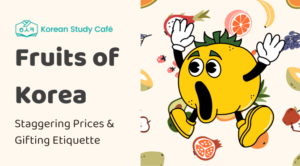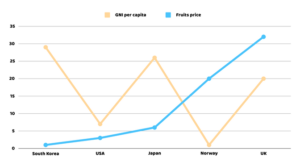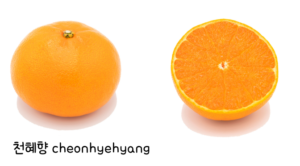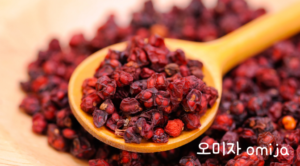Fruits of Korea: Staggering Prices & Gifting Etiquette

[ez-toc]
Introduction: Why Koreans gift fruits
Have you ever been in a situation where you needed to bring a gift for someone hosting an important gathering or for someone you want to express gratitude? You’d probably think of thank you cards, flowers, a bottle of wine or champagne, or maybe a box of chocolates or cookies, right? But what if someone expressed their gratitude with a basket containing apples, pears, and grapes? How would you react to such a gesture? In different cultural contexts, this gesture might raise some eyebrows, but in Korea, it’s not only commonplace but also widely regarded as a considerate and carefully chosen present. Yes, we are now talking about fruits. —the ones you pick up from your neighborhood grocery store. So, why do Koreans choose these readily available fruits as meaningful gifts, especially in a culture that values politeness and decorum the most?
What exactly goes through the minds of Koreans?
The Price Paradox of Fruits in Korea
Actually, there are many reasons to explain why Koreans choose fruits as gifts. One of them is straight-up – the price. Yeah, fruits in Korea are not cheap. But seriously, how expensive can fruits be, right? Let’s break it down by comparing fruit prices in the U.S. and Korea, converting them into US dollars. Since imported fruits are pricier, let’s focus on domestically grown fruits, like the tangerines from Jeju Island. In the U.S., Walmart sells tangerines at $3.97 for 3lbs, while in Korea, the cheapest tangerines at Emart would cost you around $12.61 for the same weight. According to Numbeo, a site comparing the cost of living worldwide, South Korea ranks as the most expensive country for apples, followed by the U.S. at 4th place and the UK at 32nd place. Surprising, right?
Now, let’s see these prices from the Korean perspective. It’s essential to understand that the way individuals perceive the same price can vary based on their income levels. Take, for instance, this $8 price tag on fruits. What might seem like a reasonable amount to people living in Norway, which is ranked first in gross national income per capita globally, might carry a heavier sense of burden for people living in Korea, which is positioned at 29th place. The income rankings I mentioned just now provide an overview of the economic landscape. To give you a broader perspective, the U.S. holds the 7th position, the UK is at 20th, and Japan is at 26th in 2022. Thus, the burden of the same $8 price for fruits can feel more significant for Koreans, given their position in the income rankings. Also, that was just talking about domestically produced fruits. For fruits with low domestic production, the situation gets even more intense. A watermelon at $20-30, a melon at $15, or a single red mango at $8. They are not a pleasant number at all, especially with inflation on the rise.

Bingsu Extravaganza and Prioritizing Dessert Prices
Because of these fruit prices, one of the most popular Korean summer desserts, bingsu, is becoming a luxury.
First of all, for those of you who don’t know what bingsu is, let’s see that first. Bingsu is a popular Korean dessert featuring finely shaved ice or iced milk with a snow-like texture. Commonly topped with sweetened condensed milk, it comes in various flavors, such as red beans, fruits, chocolate, and Oreo crumbs. Often served with a scoop of ice cream, bingsu is a beloved and refreshing treat enjoyed by all generations in Korea.
But can you guess how high this dessert price can be? You would be surprised. In 2023, a mango bingsu from a high-end hotel was priced at 98,000 won, $75, and that’s no joke. You might think like that’s because it’s a luxurious hotel. Well, yeah. But for context, the same hotel sells a club sandwich for $29.
In Korea, there’s a saying: “배보다 배꼽이 더 크다“, which means, “The belly button is bigger than the belly.” In English, a similar idiom might be “Putting the cart before the horse.” It’s used metaphorically to describe a situation where something less important or fundamental is bigger or prioritized over the more essential or foundational element. It reflects a humorous or ironic commentary on misplaced priorities or actions that don’t align logically. So, you can use that saying in this situation where a mango bingsu is more expensive than a sandwich.

Culprits Behind High Korean Fruit Prices
So, then, why on the earth are fruits so pricey in Korea?
Firstly, blame it on the high production costs. With 70% of South Korea’s land being mountainous and limited to being arable due to its small size, farming space is a luxury in Korea. Additionally, high wages in Korea to the mix, and voila, the production costs shoot up.
Geographical constraints force Korea to rely heavily on imports with limited transportation options, given its peninsula-like nature. This situation is exacerbated by North Korea, where any exchanges with the South are prohibited. So the prices remain high. And then, there’s this wholesale corporation in Korea, acting as an extra middleman, potentially driving prices even higher.
Despite all these challenges, surprisingly, Koreans are totally head over heels for fruits. The fruit consumption rate increased by a whopping 17.3% from 2020 to 2022. They just can’t resist them. With the rising health-conscious trend, Koreans are finding more creative ways to enjoy fruits beyond the traditional ways, peeling and juicing from diverse types of desserts, such as a variety of bingsu and tanghulu, which is sugar-coated fruits.
Occasions for Fruit Gifting in Korea
So, for these reasons, it’s no wonder that Koreans across generations love receiving fruits as gifts. The act of gifting fruits in Korea not only carries an air of sophistication but also reflects the giver’s consideration for the recipient’s health. For these reasons, Koreans gift fruits to others on many occasions.
Traditional Holidays (명절)
Traditional holidays, or 명절, mark a significant time for fruit gifting. During Chuseok, Korea’s harvest festival, and Seollal, the lunar new year, families exchange fruit sets as a gesture of prosperity for the coming year. These sets often include an assortment of fruits, meticulously arranged to symbolize abundance and unity.
Housewarming (집들이)
When visiting a friend or family member’s new home, it’s customary to bring a gift. Fruits, in this context, represent a wish for the household’s prosperity and a bountiful life in the new dwelling. The act of presenting fruits adds a touch of elegance to the warm gesture of celebrating a new chapter in someone’s life.
Expressions of Gratitude
Gratitude in Korea goes beyond mere words; it is often expressed through thoughtful gestures. Offering a beautifully arranged fruit basket is a tangible manifestation of appreciation. The recipient not only receives a delicious assortment but also acknowledges the giver’s consideration and respect.
병문안 (Visiting the Sick)
When visiting someone who is unwell, bringing fruits is a common practice. The act is twofold – it offers a nutritious and refreshing gift to aid recovery, and it symbolizes a wish for the person’s swift return to good health.
Business Meetings
In the corporate realm, gifting fruits is a subtle yet impactful way to convey respect and build positive relationships. It goes beyond the transactional nature of business, fostering goodwill and leaving a lasting impression on business partners and colleagues.
Unique Fruits of Korea
Also, there are many unique Korean fruits that you might not be very familiar with. If you want to try fruit gifting, these below might be good options.
Beyond the customary apples and grapes, Korea boasts a diverse array of fruits that contribute to the uniqueness of fruit gifting. Each of these fruits carries its own distinct flavor profile and cultural significance, making them prized additions to fruit sets.

배 /bae/ (Pear)
Korean pears, known as “bae” in Korean, differ from typical Western pears in several aspects. They are round and larger in size, resembling apples, with thin, golden skin. Korean pears are known for their crisp, crunchy texture and sweet, aromatic flavor, while Western pears tend to have a softer, buttery texture and milder taste. The unique characteristics of Korean pears contribute to their popularity in Korean cuisine.

한라봉 /hallabong/ (Hallabong)
Hailing from Jeju Island, Hallabong is a type of citrus fruit known for its vibrant color and sweet taste. It is often gifted during holidays as a representation of good fortune and a sweet start to the season.

천혜향 /cheonhyehyang/ (Cheonhyehyang)
A hybrid of tangerine and grapefruit, Cheonhyehyang is cherished for its refreshing taste. It is a popular choice for fruit sets, especially during the lunar new year, symbolizing a zesty beginning.

홍시 /hongsi/ (Over-ripe persimmon)
When persimmons become overly ripe, they transform into a soft, jelly-like consistency inside the skin. To savor this delicacy, Koreans carefully peel the skin, revealing the sweet and gooey interior. The texture is reminiscent of honey or molasses, and the intense sweetness is a treat for those with a sweet tooth. This hongshi experience is often cherished during the autumn season, offering a unique and indulgent culinary delight.

곶감 /gotgam/ (Dried persimmon)
For “곶감” (gotgam), which refers to dried persimmons in Korean cuisine, the preparation involves a meticulous process. Ripe persimmons are peeled and carefully tied with a string before being left out to dry. The natural drying process, often aided by exposure to sunlight and wind, results in a concentrated and chewy texture. The drying not only preserves the persimmons but also intensifies their sweetness. Gotgam is a popular Korean snack, enjoyed for its rich flavor and chewy consistency, making it a delightful treat during the colder months. Also, gotgam, in particular, is a delectable treat during the colder months.

매실 /Maesil/ (Korean plum)
Maesil is a Korean plum that holds cultural significance. Often preserved as a syrup or used in traditional drinks, it represents vitality and is a unique addition to fruit assortments.

오미자 /omija/ (Omija, Five-flavor berry)
Known as the “five-flavor berry,” Omija offers a complex taste profile encompassing sweet, sour, salty, bitter, and pungent notes. It is valued not only for its distinct taste but also for its perceived health benefits.
However, before you embark on gifting a fruit set, be prepared for the high price tag, ranging from $30 to a whopping $300. Surprisingly, the more expensive sets may not necessarily contain a wide variety of fruits. For instance, a premium $100 set from E-mart includes just 3 apples, 3 pears, 2 Shine Muscat grapes, and 2 red mangoes.
Conclusion
In concluding this exploration of Korean gift-giving, we find that fruits are not just a commodity but a reflection of economic landscapes, cultural priorities, and culinary creativity. The practice transcends mere tradition; it is a testament to the resilience and creativity of Koreans who turn everyday items into cherished gifts, even when the price is, quite literally, “terrifying.” So, what would you do in this situation if you found yourself living in Korea for 1-2 years? Share your thoughts in the comments below!


